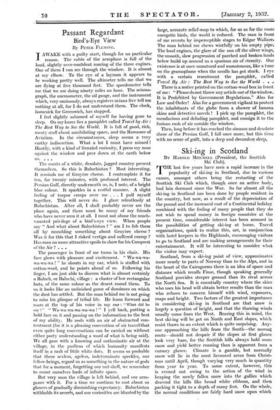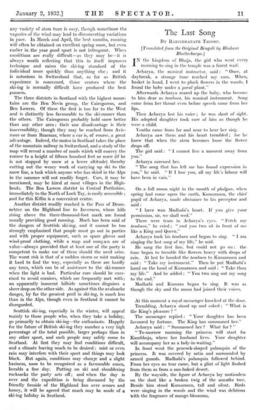Ski-ing in Scotland
BY HAROLD MITCHELL (President, the Scottish Ski Club).
TE last few years have seen a rapid increase in the popularity of ski-ing in Scotland, due to various causes, amongst others being the restarting of the Scottish Ski Club which, though once an active body, had lain dormant since the War. So far almost all the ski-ing in Scotland nas been done by people resident in the country, but now, as a result of the depreciation of the pound and the increased cost of a Continental holiday combined with the feeling of many people that they do not wish to spend money in foreign countries at the present time, considerable interest has been aroused in the possibilities of getting ski-ing at home. Travel organizations, quick to realize this, are, in conjunction with hotel keepers in the Highlands, encouraging visitors to go to Scotland and are making arrangements for their entertainment. It will be interesting to consider what the visitor may expect.
Scotland, from a ski-ing point of view, approximates more nearly to parts of Norway than to the Alps, and in the heart of the Cairngorms there is an idea of space and distance which recalls Finse, though speaking generally Scotland provides steeper ground than its rival across the North Sea. It is essentially country where the skier who uses his head will obtain better results than the man who refuses to concern himself with wind, exposures, maps and height. Two factors of the greatest importance in considering ski-ing in Scotland are that snow is largely a question of height, and that the thawing winds usually come from the West. Bearing this in mind, the best ski-ing will be got on North and East slopes, which
resist thaws to an extent which is quite surprising. Any- one approaching the hills from the South—the normal route—should not despair if the slopes at first glance look very bare, for the Scottish hills always hold more snow and yield better running than is apparent from a cursory glance. Climate is a gamble, but normally snow will lie in the most favoured areas from Christ- mas until April, though varying very much in quantity from year to year. To some extent, however, this is evened out owing to the action of- the wind in heaping the newly fallen snow into the gullies which descend the hills like broad white ribbons, and then packing it tight to a depth of many feet. On the whole, the normal conditions are fairly hard snow upon which
any variety of stem turn is easy, though sometimes the vagaries of the wind may lead to disconcerting variations in pace. In March and April, the best months, running will often be obtained on excellent spring snow, but even earlier in the year good sport is not infrequent. When conditions are really difficult—as they may be—it is always worth reflecting that this in itself improves technique and raises the ski-ing standard of the individual more quickly than anything else ; and it is notorious in Switzerland that, so far as British experience is concerned, those centres where the ski-ing is normally difficult have produced the best runners.
The three districts in Scotland with the highest moun- tains are the Ben Nevis group, the Cairngorms, and Ben Lawers. Of these the first is too far to the West and is distinctly less favourable to the ski-runner than the others. The Cairngorms probably hold snow better than any other area ; their one disadvantage is their inaccessibility, though they may be reached from Avic- more or from Braemar, where a car is, of course, a great advantage. Indeed, the motor in Scotland takes the place of the mountain railway in Switzerland, and a study of the map will reveal a number of roads which will convey the runner to a height of fifteen hundred feet or more (if he is not stopped by snow at a lower altitude) thereby cutting out the weary work of carrying up ski to the snow line, a task which anyone who has skied in the Alps in the summer will not readily forget. Cars, it may be mentioned, may be hired at most villages in the High- lands. The Ben Lawers district in Central Perthshire, immediately to the North of Loch Tay, is easily accessible ; and for this Killin is a convenient centre.
Another district readily reached is the Pass of Drum- odder on the Highland line to Inverness, where hills rising above the three-thousand-foot mark are found usually providing good running. Much has been said of the dangers of Scottish ski-ing, and it cannot be too strongly emphasized that people must go out in parties and with proper equipment; such as spare gloves and wind-proof clothing, while a map and cornFass are of value—always provided that at least one of the party is competent to make use of them should the need arise. The worst risk is that of a sudden storm or mist making it hard to find the way, especially as there are hardly any trees, which can be of assistance to the ski-runner when the light is bad. Particular care should be exer- cised to avoid cornices, which are frequently met with; an apparently innocent hillside sometimes disguises a sheer drop on the other side. As against this the avalanche danger, by far the greatest peril in ski-ing, is much less than in the Alps, though even in Scotland it cannot be disregarded..
Scottish ski-ing, especially in the winter, will appeal mainly to those people who, when they take a holiday, go primarily to obtain ski-ing—the enthusiasts. Happily for the future of British ski-ing they number a very high percentage of the total possible, larger perhaps than in any other sport, and such people may safely come to Scotland. At first they may find conditions difficult, and a climate leaving much to be desired : mist or even rain may interfere with their sport and things may look black. But again, conditions may change and a slight haziness, soon to be recognized as a favourable omen, heralds a fine day. Putting on ski and shouldering rucksacks the party sets off ; and when the day is Over and the expedition is being discussed by the friendly fireside of the Highland Inn over scones and honey, it will be agreed that Much may be made of a ski-ing holiday in Scotland.







































 Previous page
Previous page